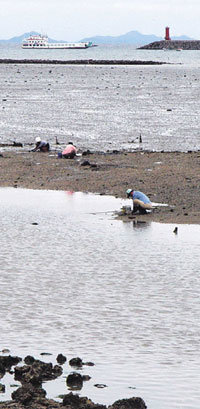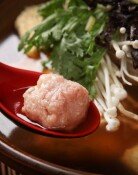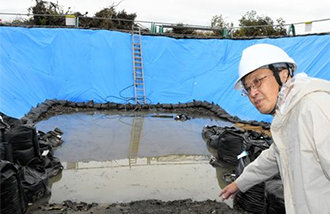At a Watercolor Seaside Village, the White Spider Lily Sheds a Tear
At a Watercolor Seaside Village, the White Spider Lily Sheds a Tear
Posted September. 02, 2004 22:13,

Monday morning at Gyeokpo Port (Buan-gun, Jeonlabuk-do) on the Byeonsan Peninsula. The bustle of the weekend has dissipated without a trace. In the sky, seabirds trace their lazy arcs, while on the water, baby gar fish swim and dive in the leisurely calm. Even the car ferry, which weaves its way past the breakwater into the port with faraway Wi Island in the background, seems unhurried. This morning, Gyeokpo Port has emerged from the busy weekend and returned to its usual peace and stillness.
For the city worker, even a weekend trip is a bold luxury. Introducing the ease and quiet of this port on Monday mornings to such a one might be too much of a tease, a form of emotional violence, as it were. But Gyeokpo is well worth a shot, should the opportunity present itselfespecially for someone who has tired of weekend trips that make you waste precious hours on the road, that pile on more exhaustion and irritation rather than deliver on their initial promise of rest and renewal.
Autumn comes from the skies. Although the temperature at midday is still that of summer, from the third-floor deck of the car ferry as it travels toward Wi Island with the Byeonsan Peninsula at its back, the march of islands upon the West Sea can be seen with crystal clarity against the cobalt of a fall sky. Sinsi-do, Munyeo-do, Seonyu-do, Jangja-do The Gogunsan Islands on the shores of Gunsan, home of the controversial, trouble-ridden Saemangeum Embankment.
A quick boat ride of 50 minutes brings me to Pajanggeum on Wi Island. The islands only public bus comes into view. The bus operates along a road that circles the entire island. Among the myriad islands around the peninsula, those equipped with its own circular road are few and far between. Theres a tragic history behind Wi Islands initiation into that select group: the capsizing of the West Sea ferry in 1993, which left 292 people killed or missing. This road was built for the grief-stricken inhabitants of the island.
With the summer vacationers gone, the island has returned to its lazy routine. The muddy tidal flat accommodates a single fishing boat, sitting askew after the tide has gone. A woman digs for shellfish with rapid motions. The narrow channel of tidewater is the share of the country wife who is fishing for something to put on the dinner table. In this tranquility, the recent commotion surrounding the construction of a radioactive waste treatment facility seems like a thing of the distant past.
I set off on a tour of the island (26km) on the public bus. The fare is 2,000 won, the duration 45 minutes. A two-lane asphalt road runs all round the outskirts of the island. It passes by villages now and then, but it travels mostly along beaches and coastlines halfway up the mountainside. From my vantage point upon the road, the island looks like a forest plunged into the middle of the sea, a dense rock islandand the view is boundless. It is second not even to the scenery from the Baeksu Coastal Road in Yeonggwang, Jeonlanam-do. And with the sunset adding to its beauty, the view requires no words.
Many of the village names on the island end with the letter geum (金, gold): Pajanggeum, Beolgeum, Nongeum, Miyeonggeum, Jeonggeum, Gipeungeum These villages, known as the Twelve Geums of Wi Island, are all ports. I ask around about the history of the names, but no one seems to know for certain. The floating rumor is that the villages were so named because they were located where they were likely to bring in money. This happy foresight reaped its rewards in the last century, when the close-lying waters off of Chilsan overflowed with boats fishing for yellow corvina. Once the seasonal fish markets sprang up on Wi Island, the earnings were good in every village.
Visitors to Wi Island at this time of year should look for a rare wildflower named the White Spider Lily, or white sangsahwa in Korean. Unlike the Magic Lily (or red sangsahwa) which abounds during the same season in the forest on the grounds of Seonun Temple in Gochang, the blossoms of the White Spider Lily, also known as Wi Island Sangsahwa, are snow white. They start to bloom in mid August and last about a month.
Of course, Wildflower Expert Kim Tae-jeong, who is head of the Korean Wildflower Research Institute, would never pass up the chance to see these beauties. Today, hes on board the Wi Island ferry with his fellow researchers from the institute. The Korean name sangsahwa derives from the fact that the flower and the leaves never meet: after the leaves wither, there is a period of dormancy before the flower blooms alone upon its stalk.
I finally come across White Spider Lilies near a hackberry tree in Jinli village, finding my way by asking from door to door. I had been worried that the stalks would have snapped in the overnight storm, but fortunately the blossoms were all intact. The white flowers, perched in clusters of three or four at the end of smooth stalks standing 50cm tall, were swaying gently in the westerly wind under a deep-blue sky.
On my way around the island, I stop at a beach in Nongeum Village. Fluttering all around are banners of the Joseon Dynasty navy. This is the outdoor set of the soon-to-be-aired TV drama, Lee Soon-shin, the Indestructible. But the seashore seems oddly familiar; a sign tells me that this was also the set for the movie, Coastline. The traditional dwelling that was built to serve as Admiral Lee Soon-shins command post is used as a minbak inn on days when there is no shooting schedule. A night in the room where the admiral wrote his famed war diaryalthough its just a set, the charming hanok house with its seaside view should provide a memorable experience.
Travel Information
◇ Directions ▽ Wi island: Board the car ferry at Gyeokpo port. 14.5km, 50 minutes. 24,000 won per car (driver included), 6,700 won per passenger. Fares per one-way trip. Operated by Gyerim Shipping and Transport. 063-581-1997. Departure times vary according to the tides. ▽ Gyeokpo: West Sea Coastal Highway ∼ Nadeulmok, Buan (a.k.a. Julpo Nadeulmok) ∼ Route 30.
◇ Inquiries △ Myeon Office 063-583-3804 △ Nongeum movie and television set: picnics on the sand, fishing, and overnight stays available △ Wido Ooseung Tourism & Leisure (Contact: Baek Un-gi) 063-583-3875 △ Buan-gun: www.buan.go.kr △ Wi Island website: www.wido.com
Restaurants
Gyeokpo Port embraces the famous Chaeseok River on the Byeonsan Peninsula. Clam soup (30,000 won), flavored with fresh clams and green chili peppers and redolent of the sea, is a Byeonsan specialty. Bonglae Hoetjib (063-584-4340) uses only live clams taken straight from the tanks.
Clams are mainly found on the tidal flats of Gyehwa Island, on the northern tip of the peninsula (it has now become reclaimed land). Hyundai Susan Hoetjib (063-583-1895), in old Seom Maul (Gyehwa-ri), sells ample portions of natural (non-cultured) raw fish for inexpensive prices. A single table setting costs 30,000 won. The seafood served here is personally caught and brought in from off the coast of Sinsi Island by the owner Kim Cheol-su. During this time of year, when the gizzard-shad is plentiful, Gyehwa-style gizzard wraps, folded with old kimchi and dipped in sesame oil, is a particular delight.
Seung-Ha Cho summer@donga.com







